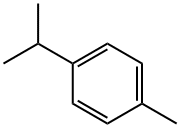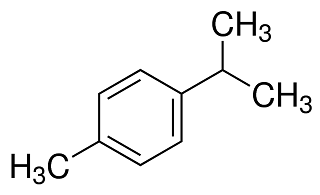
p-Cymene
- Product Namep-Cymene
- CAS99-87-6
- CBNumberCB9262508
- MFC10H14
- MW134.22
- EINECS202-796-7
- MDL NumberMFCD00008893
- MOL File99-87-6.mol
- MSDS FileSDS
Chemical Properties
| Melting point | -68 °C |
| Boiling point | 176-178 °C(lit.) |
| Density | 0.86 g/mL at 25 °C(lit.) |
| vapor density | 4.62 (vs air) |
| vapor pressure | 1.5 mm Hg ( 20 °C) |
| refractive index | n |
| FEMA | 2356 | P-CYMENE |
| Flash point | 117 °F |
| storage temp. | 2-8°C |
| solubility | Chloroform (Sparingly), Ethyl Acetate (Slightly) |
| form | Liquid |
| color | Clear |
| Odor | Mild, pleasant; aromatic, solvent-type. |
| Odor Threshold | 0.057ppm |
| explosive limit | 5.6% |
| Odor Type | terpenic |
| Viscosity | 0.81-7.1mm2/s |
| biological source | synthetic |
Safety
| Symbol(GHS) |
  
|
|||||||||
| Signal word | Danger | |||||||||
| Hazard statements | H226-H304-H361f-H411 | |||||||||
| Precautionary statements | P201-P202-P210-P273-P301+P310-P331 | |||||||||
| Hazard Codes | Xi | |||||||||
| Risk Statements | 10-36/37/38 | |||||||||
| Safety Statements | 26-36 | |||||||||
| RIDADR | UN 2046 3/PG 3 | |||||||||
| WGK Germany | 2 | |||||||||
| RTECS | GZ5950000 | |||||||||
| Autoignition Temperature | 817 °F | |||||||||
| TSCA | Yes | |||||||||
| HazardClass | 3 | |||||||||
| PackingGroup | III | |||||||||
| HS Code | 29029090 | |||||||||
| Hazardous Substances Data | 99-87-6(Hazardous Substances Data) | |||||||||
| Toxicity | LD50 orally in rats: 4750 mg/kg (Jenner) | |||||||||
| NFPA 704: |
|



